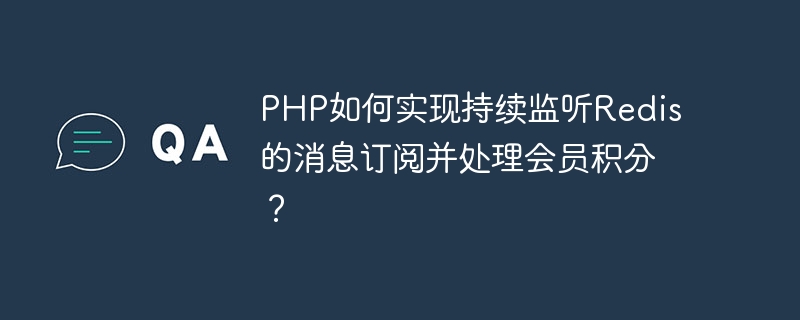

How does PHP implement continuous monitoring of Redis message subscriptions and process member points?
Redis is a high-performance key-value storage system that is often used as the implementation of message queues. During development, we often encounter scenarios that require real-time processing of messages, such as processing changes in membership points. This article will introduce how to use PHP to continuously monitor Redis message subscriptions and handle changes in member points.
Before starting, we need to install the Redis extension and install the Composer tool.
First, make sure you have installed the Redis extension. You can check it with the following command:
php -m | grep redis
If you see "redis" in the output, it means that the Redis extension has been installed. If it is not installed, please install the corresponding Redis extension according to your operating system and PHP version.
Next, we need to install the Composer tool. Please visit [https://getcomposer.org/](https://getcomposer.org/) and follow the official guide to install it.
First, create a new folder in the command line, and then enter the folder.
mkdir redis-subscribe cd redis-subscribe
Next, use Composer to initialize a new PHP project.
composer init
Follow the prompts and enter the project name, description and other information. After completion, a composer.json file will be generated in the current folder.
Then, we need to install a Redis client library, here we choose to use the predis/predis library.
composer require predis/predis
After the installation is completed, Composer will generate a vendor folder under the current folder, which contains the required dependent libraries.
Next, create a new PHP file index.php, which is used to write the code for Redis message subscription and points processing.
<?php
require 'vendor/autoload.php';
use PredisClient;
$redis = new Client();
$redis->subscribe(['member-points'], function ($redis, $channel, $message) {
// 处理消息
$data = json_decode($message, true);
// 根据消息类型处理积分
if ($data['type'] === 'add_points') {
addPoints($data['user_id'], $data['points']);
} elseif ($data['type'] === 'deduct_points') {
deductPoints($data['user_id'], $data['points']);
}
});
function addPoints($userId, $points)
{
// 处理增加积分逻辑
echo "增加{$points}积分给用户{$userId}" . PHP_EOL;
}
function deductPoints($userId, $points)
{
// 处理扣除积分逻辑
echo "扣除{$points}积分给用户{$userId}" . PHP_EOL;
}The above code introduces the autoloader generated by Composer through require 'vendor/autoload.php';. Then, a Redis client instance $redis is created, and the $redis->subscribe() method is used to subscribe and process messages.
In the $redis->subscribe() method, we use the anonymous function as a parameter and execute the message processing logic in the function body. Here we assume that the message structure is a JSON string, including two fields: user_id and points, and a type field to identify the message type. According to different message types, the corresponding processing function is called.
In the processing function, we add or subtract the points of the corresponding user accordingly. Here, a message is simply printed. In actual applications, corresponding business logic processing can be performed according to needs.
Now, we can start Redis message monitoring to handle changes in member points. Execute the following command in the command line:
php index.php
At this time, the PHP script will enter the listening state and wait for messages in Redis in real time.
In another terminal, we can use the PUBLISH command of Redis to publish a message about changes in member points. For example, we can use the following command to send a message to increase points:
redis-cli PUBLISH member-points '{"type":"add_points","user_id":123,"points":100}'Then, you will see the corresponding processing results in the output of the PHP script.
Through the above steps, we have successfully implemented continuous monitoring of Redis message subscriptions in PHP, and processed changes in member points based on different types of messages. This Redis-based message subscription and processing mechanism can be flexibly applied in various real-time message processing scenarios.
I hope this article will help you understand how to use PHP to implement Redis message subscription and process membership points. If you have any questions or suggestions, please leave a message for discussion.
The above is the detailed content of How does PHP implement continuous monitoring of Redis message subscriptions and process membership points?. For more information, please follow other related articles on the PHP Chinese website!
 What should I do if the ps temporary disk is full?
What should I do if the ps temporary disk is full?
 How to solve the slow download problem of Baidu Netdisk
How to solve the slow download problem of Baidu Netdisk
 Comparative analysis of vscode and visual studio
Comparative analysis of vscode and visual studio
 How to enter BIOS on thinkpad
How to enter BIOS on thinkpad
 dynamic photo album
dynamic photo album
 what is css
what is css
 What is a hidden element in jquery
What is a hidden element in jquery
 The difference between injective and surjective
The difference between injective and surjective




